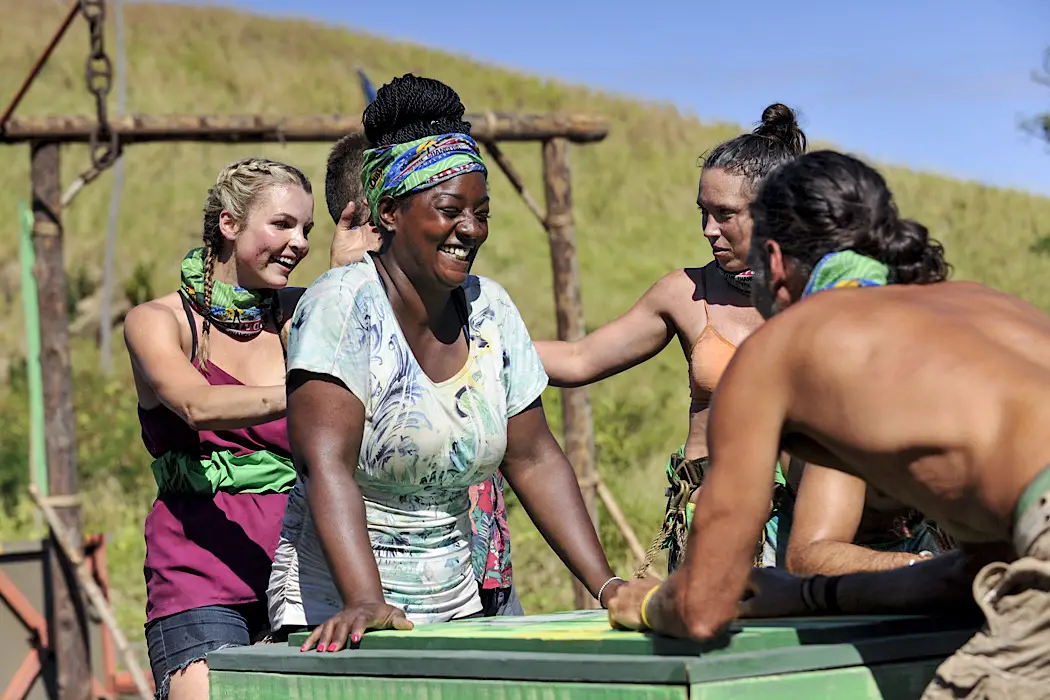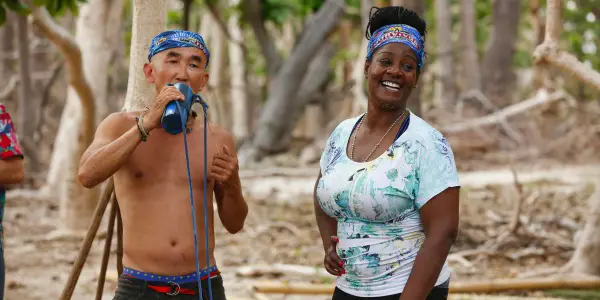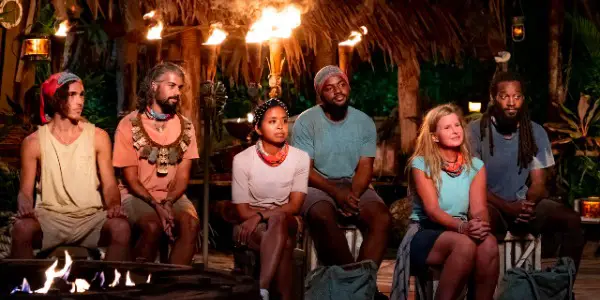REALITY TV ISN’T TRASH: THE EDITING OF SURVIVOR

Alex is a film addict, TV aficionado, and book lover.…
Yeah, I giggle when I hear the name Parvati. I love a good blindside, a well-used idol, a poorly used idol, and I would go to an island, backstab my alliance, and starve myself for 39 days to make sure Cirie Fields finally wins the thing. I love Survivor, the 20-year-old show that “strands” contestants in the wilderness and forces them to vote each other off until a Sole Survivor is crowned. The show just wrapped up its 41st season, and while its longevity is commendable in and of itself, it was also critical in making reality TV a staple of the modern television landscape.
Few give it a pat on the back for this feat and many openly deride it for helping make such a hated and dismissed genre popular. Oh, you think reality TV is brainless garbage that lulls us into being placid couch consumers while the world’s problems spin out of control? How astute! What a positively withering, damning take on the wielding of entertainment as crowd control!
Chill out. I’m not saying you have to like Survivor or any of its reality TV brethren, but maybe don’t dismiss it as devoid of use and meaning. Entertainment is use. Its ability to revitalize and recharge is an essential part of life, one that everyone turns to in one way or another, and the craft of it, especially to keep it going this long, isn’t easy. The people who created Survivor hit on a format that works, one that relies heavily on mystery and thriller elements with a dash of what-are-you-doing unpredictability that comes from real people making real (and often bad) decisions. There’s craft here, and there are things to learn from how footage of people scheming, arguing, and competing for 39 days is turned into a consistent salve for the brain.
An Unchanging Format
Obviously, Survivor has changed over 41 seasons, but the structure they use has been remarkably consistent. The repetition is part of its charm, a soothing ingredient that is key to its comfort.
There’s something akin to rigid film genres at work here. Think about how often slice ‘em and dice ‘em horror films are described in the same way. Horrible things are happening onscreen and characters are in mortal peril, but versed fans of the genre can sink into their chairs with resplendent ease. It’s not that they aren’t paying attention; it’s that they know what blows are coming, feel the timing of buildup and release in their bones, and find comfort in that familiarity.
Survivor offers up much the same experience because, despite details of gameplay changing, the structure of their stories have not. Fans know what to expect from season to season, episode to episode, and even moment to moment. If horror fans can feel the knife coming down, Survivor fans can feel the blindside darting in, all of which comes from remarkably sound story beats constructed again and again by its editors.
There are two main story arcs to Survivor: the episode arc and the season arc. Groundbreaking, I know, but the simplicity makes for a fine-tuned television machine. Overall, it is a single competition per season where 16 to 20 people vote each other out one by one until the competitors are whittled down to a group of two or three finalists. Then, a jury of eliminated players chooses the winner of the season from these finalists (the Sole Survivor).

This breaks down into pretty clean episode and season arcs, with episodes building up to a person being eliminated while overall plans and strategy develop in the background to bring out a satisfying, deserving winner. Straightforward enough until you remember that this isn’t scripted and all must be constructed by editors from the waffling, mistake-ridden decisions of half-starved human beings who aren’t sleeping.
The episode arc itself has an outline rooted deep in season 1, with almost no changes to its structure over the ensuing years. Every week you get a minute of recap from the previous episode, a check-in with the players and the group dynamics, one or two challenges, another check-in with the players to set up potential voting scenarios, and lastly the tribal council, where players vote and one person is sent packing (joking, they don’t have luggage, but every once in a while someone hands off a jacket).
Few official interviews or deep dives into the editing process has been done (again, people don’t take the construction of reality shows seriously), but per a lone interview with Cinemontage, the journal of the motion pictures editors guild, each 40-minute episode, with that rigid structure, comes from approximately 1,440 minutes of footage (3 days of real-life playing time). That’s simultaneously a lot a little, providing editors with an extraordinary amount of footage to sort through and massage into a story with little game time for things to fundamentally change. And yet anyone who watches the series knows that the dynamics can change drastically from episode to episode, some of which (particularly in later seasons) is due to the complex and breakneck strategies employed by the players. Others, though, come from editors simply struggling to keep all of the players and their strategies in the audience’s mind.
Successes and failures by the editing team have been picked up by hardcore fans, who have done more to break down the editing of the show than any trained, formal media outlets have done. If you even lurk in the fandom then you know what a purple edit is (a moniker given to a player who is rarely seen, easy to forget, and will obviously not be a contender, so named for season 21 contestant Kelly Shinn). You’ll see us tweeting something like “Tribal Council already!? WTF something’s going down!!!!” if it starts before its allotted last ten minutes of an episode. Some even claim there’s a winner’s edit, which is an elaborate breakdown of player screen time, individual interviews, and soundbites, all of which will (allegedly) tell you who is going to win early on. I’ve never been able to make heads or tails of this, but I have to applaud the Insider Baseball level of detail these people have put into understanding the show they love.
None of that would be possible if the editors weren’t organized and consistent in their approach to the show, putting an incredible amount of work into making a recognizable and digestible TV show from an extraordinary amount of chaotic footage.
Evolution of Game
Whereas structure has remained the same over 20 years, the game of Survivor itself has changed radically, as evidenced by the performance of players in season 40. That season was the long-awaiting showdown between previous Sole Survivors aptly called Winners at War. A cross-section of winners from all eras of the game was brought in and competed against each other, and recent players steamrolled the so-called old-schoolers. The players themselves used the terms new school and old school, referencing a fundamental shift in the game’s reliance on advantages introduced by production and the lightning-fast play of the contestants, which old-schoolers proved incapable of adapting to. None of this has changed the fundamentals of the game, which has allowed the editors to keep the same structures for episodes and seasons, but it has influenced the stories the editors need to build within those structures.
Most of the changes have kept the game fresh for avid viewers, and any that didn’t go over so well was quickly jettisoned. Infamous among the misfires is the 38th season, Survivor: Edge of Extinction, which introduced the titular way for eliminated players to re-enter the game.
Players having the opportunity to come back after being voted out wasn’t unknown to Survivor (a similar twist called Redemption Island had been used three times previously). Edge of Extinction, though, revealed the gamble production took with these twists, and when it didn’t pay off in season 38, the editors were unable to salvage a usable story.
The issue came with the potential for a player voted out at the beginning of the game returning at the very end and winning, leaving the editors with little gameplay for them to construct a season-long edit that builds the winner up. That’s exactly what happened with Sole Survivor Chris Underwood, who was voted out in the third episode of the season and returned in the 13th (and last) episode. That’s 8 of 13 episodes in which the winner of the game wasn’t playing the game, and no amount of intense beefing up of his endgame scrambling (which admittedly featured some great gameplay) could overcome the sense that those 8 episodes were a waste of time.
The irrelevant episode is the most common Survivor editing mistake, which generally comes about when a player receiving a purple edit is voted out. If the climax of your episode is eliminating players that viewers forgot was there, that’s bad season-long editing, and only a carefully constructed episode edit (with the help of in-game drama) can save the show from that mistake. Over 20 years, there’s been plenty of routine eliminations of these players, and while a single perfunctory episode is deflating, having 8 of them in one season is deadly. That’s what the Edge of Extinction twist did to its editors: gave them 8 irrelevant eliminations. They did their best to fill in the time with fun gameplay, leaning hard on the boisterous and dynamic contestant Rick Devens, but they were handed a story no amount of great editing could save.

Other updates to the game have worked into the editor’s hands, particularly the aforementioned acceleration of gameplay. When Survivor started it was closer to a real-world scenario: drop a bunch of people off in the wilderness with little supplies and see if they could work together to survive. Contestants immediately conceived of alliances to protect themselves from the group’s vote, but these were built and formed more on social affinity and survival ability than they were in later years. If you could get food and were a pleasant person to be around, you could go far. Later seasons, though, saw players coming in with a nuanced understanding of Survivor as a game, and real-world ethics and considerations went out the window. People were willing to starve for 20 days and keep annoying people around if it meant that they were more likely to win a million dollars, and players openly discussed alliances on these terms. With this came the acknowledgment of backstabbing and temporary alliances, and as long-term gameplay became less stable, episode arcs thrived. The segments where you catch up with group dynamics and establish possible targets accelerated to a blistering pace, with the possibilities, and the willingness of players to use those possibilities, giving editors the ability to construct more narratives than they could possibly fit into the episode. Options became the lifeblood of Survivor and dangling three, four, five of them in front of the audience worked like catnip. It’s classic suspense: which door will people choose? And with players routinely leaving their options open through tribal council (later seasons have allowed players to get up and strategize within this setting, which was originally envisioned as an interview of the players right before they voted), the suspense became easy to establish.
And yet, on occasion episodes have abandoned this thrill-seeking approach, grasping the show’s original intent as a social experiment back from the clutches of devious players. Two main episodes exemplify this, and both cued in viewers early because of their extended time devoted to tribal council.
The first was season 34 episode 6, or the time Varner outed Zeke as a transgender man during tribal. The way this started was like, well, a bad TV show: Varner presents it as a deception, playing into a longstanding cultural narrative that has been incredibly harmful to trans people. Watching him pull out familiar lines made you cringe, and there was a breathless moment where viewers waited for the other contestants to buy into these ideas. And yet, after that breath, every player turned on Varner, immediately calling out the narrative Varner tried to wield as false. It was at once a deeply troubling bit of television and a hopeful one; here, a cross-section of the American public showed that they had moved beyond a narrative they had been fed, and the episode became not only a reflection of the shifting cultural understanding of gender but a rejection of plotlines other storytellers had utilized for decades.
Another prominent one came just a few weeks ago and was the culmination of a multi-series plotline that saw the four remaining Black players form an alliance. Now, Survivor, like a lot of reality shows, has a complicated history when it comes to racism in casting, production, and gameplay (they did do a season that divided the cast by race). This was the first season under CBS’ promise that all unscripted reality shows would have casts that are at least 50% BIPOC, and this led to a series-high number of Black players in the cast. The Black players who survived to the merge saw a rare opportunity to work together, but eventually, this alliance did turn on each other. While dealing with the fallout, one of the contestants, Deshawn, aired how the cultural pressures of the last couple years, with rising and prominent discussions of racism in America, along with the regular (but usually unspoken) pressures that come with being a Black player, took their decisions far outside of gameplay. Discussion of strategy essentially stopped in order to examine how American culture influenced the game of Survivor, both in gameplay and in construction, and in doing so the show became a meta version of the social experiment it originally was.
Neither episode broke the season-long arc or made Survivor anything it wasn’t, but they did remind viewers of the show’s flexibility and revealed its deliberate choice to be, consistently, the show that it is, only varying from its fine-tuned structure when it found itself with extraordinary moments of television.
Conclusion: An Editing Survivor
No, Survivor is not a secret masterpiece that everyone should be watching for their edification, but it doesn’t deserve the void of examination it’s received. Good reality TV is hard to make, just like any other TV show, and one that has survived over 40 seasons with ardent fans has to be doing something right. Reality TV is made in the editing room, and the editors of Survivor deserve respect for keeping the show interesting but still recognizable all these years later.
Do you watch Survivor? If so, have you noticed yourself picking up the rhythms of its editing? Let us know if you have in the comments!
Does content like this matter to you?
Become a Member and support film journalism. Unlock access to all of Film Inquiry`s great articles. Join a community of like-minded readers who are passionate about cinema - get access to our private members Network, give back to independent filmmakers, and more.
Alex is a film addict, TV aficionado, and book lover. He's perfecting his cat dad energy.













